Biden pays tribute to ‘good friend’ John McCain at Hanoi monument marking where late senator’s plane was shot down before he spent 5.5 years in Vietnam as a prisoner of war
President Joe Biden paid tribute to John McCain on Monday by visiting the monument in Hanoi that marks where the late senator’s plane was shot down before he spent five and a half years as a prisoner of war in Vietnam.
Biden was accompanied by former Secretary of State and Senator John Kerry, who, like Biden, was one of McCain’s colleagues in the Senate, but unlike McCain returned from his service in Vietnam to become one of the faces of the American anti-war movement.
The president spent the morning with Vietnamese officials as the U.S. diplomatic status with the nation was upgraded, before making a final stop at the statue, located on the shore of Trúc Bạch Lake.
‘I miss him. He was a good friend,” Biden said, adding, “It was important to me,” when a reporter asked him why he made the stop part of his official visit.
There was already a wreath of red, white and blue flowers in front of the statue, with a naval and naval officer next to it.
President Joe Biden paid tribute to John McCain on Monday by visiting the monument in Hanoi that marks where the late senator’s plane was shot down before he spent five and a half years as a prisoner of war in Vietnam
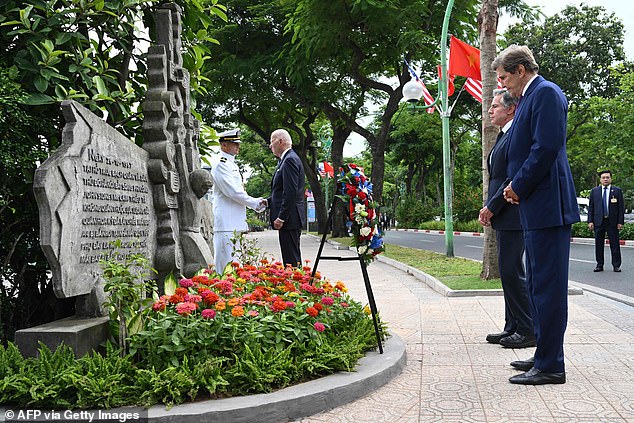
Biden was joined by former Secretary of State and Senator John Kerry (right), who like Biden was one of McCain’s colleagues in the Senate, but unlike McCain returned from his service in Vietnam to become one of the faces of the American anti-war movement
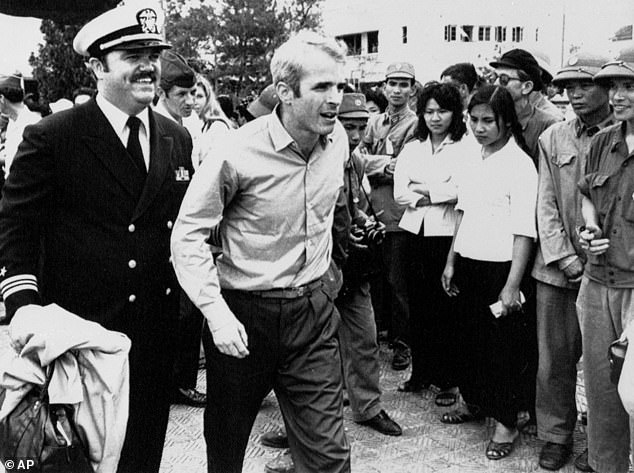
John McCain is photographed on March 14, 1973, the day he was released from a prison camp in Hanoi after spending five and a half years as a prisoner of war by the North Vietnamese.
The president touched the wreath and bowed his head.
He then shook hands with the officers and gave them challenge coins.
Kerry and Secretary of State Antony Blinken lingered nearby.
The president was headed to the airport to fly to Alaska — to briefly mark 9/11 and refuel Air Force One — and then to DC, ending his five-day Asia trip that took him around the world.
Biden met McCain in the 1970s as a military aide assigned to the young senator from Delaware, and before long the Arizona Republican had suffered greatly at the hands of the Vietmanese.
McCain described the brutal treatment he received as a prisoner in North Vietnam for five and a half years to U.S. News & World Report in 1973which was republished in 2008 while he was running for president.
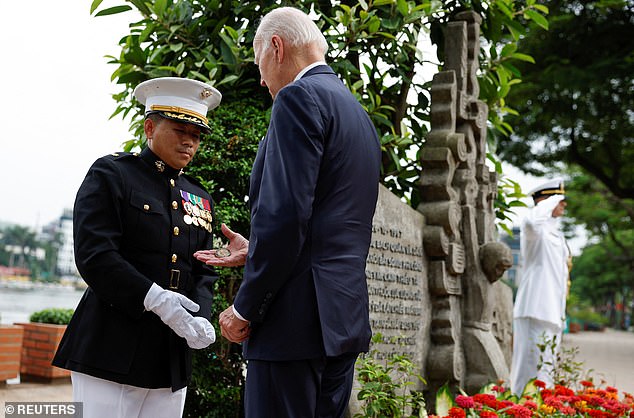
President Joe Biden gave presidential challenge coins to the Navy and Marine Corps officers standing at the John McCain Monument in Hanoi, Vietnam, on Monday
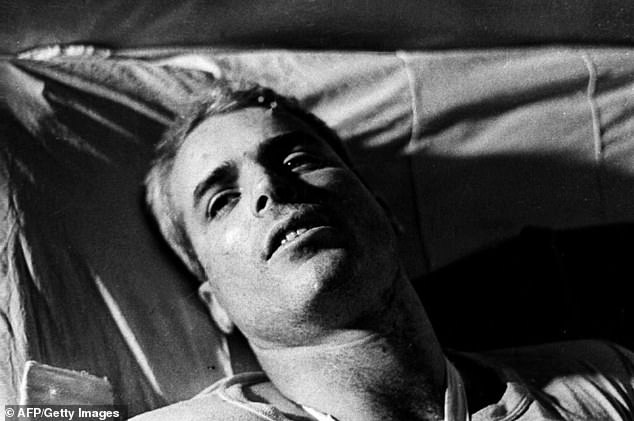
A 1967 photo shows Naval Air Force Major John McCain lying in bed in a Hanoi hospital after his plane was shot down
He recalled Oct. 26, 1967, when a Russian missile the size of a telephone pole tore the wing off his Skyhawk dive bomber.
The force with which the plane was ejected broke the right leg and both arms.
After nearly drowning from the weight of his equipment, he was kicked and spit on by some townspeople at the edge of the lake, and also stabbed in the groin with a bayonet, before an ambulance took him to a prison.
There, McCain was interrogated and denied medical care.
At one point, McCain agreed to talk — with agents citing a “psychotic torture” called “The Bug” — but a “completely incompetent” doctor named “Zorba” said the future senator was too far gone.
The North Vietnamese eventually helped McCain when they realized he was a “great admiral.”
McCain’s father, John S. McCain Jr., was the commander of the Pacific War.
‘They thought that because my father had such a high military rank, I belonged to the royal or ruling circle. They have no idea how our democracy functions,” McCain noted during his hospital stay.
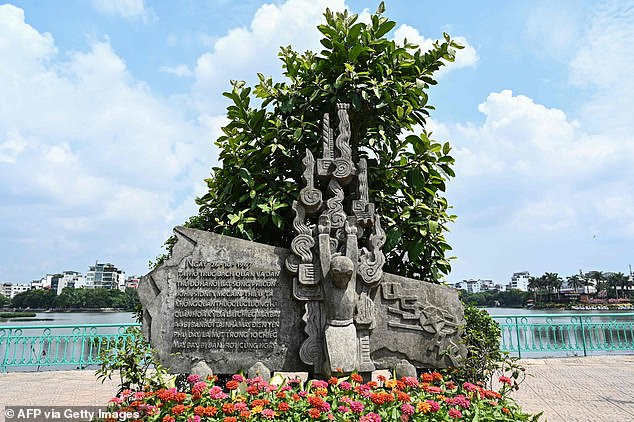
An image of the sculpture depicting the capture of the late Senator John McCain in Hanoi, Vietnam
Yet he was treated terribly.
“They said I needed two surgeries on my leg, but because I had a ‘bad attitude,’ they didn’t want to give me another surgery,” McCain recalled.
After his time in the hospital, McCain was transferred to a camp called ‘The Plantation’ where he was held in solitary confinement for over two years.
He recalled that he could barely bathe and had to use a bucket with an ill-fitting lid as a toilet.
If McCain did get some human interactions, it was the North Vietnamese who pushed him to confess to war crimes or asked him to lie and say on the record that the treatment he received was humane.
In 1969, after three Americans were released from POW camps, President Richard Nixon began publicizing the horrific treatment, which McCain said improved his life.
But he was still beset by illness.
He recalled that in late 1969 he “weighed only 105, 110 pounds, was boiling all over and was suffering from dysentery.”
Nixon’s bombing of Saigon in 1972 prompted McCain’s eventual release on March 14, 1973.
Biden came into McCain’s life a few years later and even forced him to start a political career, despite the fact that they would be members of different parties.
This came to a head in 2008, when Biden was selected as the nominee for the Democratic nominee, Senator Barack Obama.
McCain led the Republican presidential ticket with Alaska Governor Sarah Palin as his vice president.
The Democrats would go on to win that race, while McCain remained in the Senate and served until his death from brain cancer on August 25, 2018.
Biden delivered his eulogy.
When Biden ran his own presidential campaign during the 2020 cycle — against Republican President Donald Trump — he received a major endorsement from Cindy McCain, John McCain’s widow.
She was hurt and disturbed by some of Trump’s comments about her late husband.
Early in Trump’s presidential career, Trump mocked McCain for his status as a prisoner of war.
“I like people who haven’t been captured,” Trump said.
McCain, known as a political “maverick,” later hit back at Trump by refusing to cast a presidential vote that would have allowed the Republican to proclaim he had repealed Obamacare.
Cindy McCain also retaliated, helping Biden turn Arizona blue in the 2020 election.
She was rewarded with an ambassadorship and served for two years as U.S. ambassador to the United Nations food and agriculture agencies.
The late senator’s daughter, Meghan McCain, now a columnist for DailyMail.com, also sometimes supported Biden.
In April 2019, as Biden was about to announce his presidential campaign, Meghan defended him after a handful of women complained he was too touchy.
“Joe Biden is one of the truly decent and compassionate men in all of American politics. He helped me through my father’s diagnosis, treatment and eventual death more than any of my father’s friends combined.” she tweeted. “I wish there was more empathy from our politicians, not less.”
But Meghan, a Republican like her father, has expressed deep disappointment in Biden’s performance as president.
“The man I once considered a friend and confidant has turned into a worthless and unreliable leader I no longer recognize,” she wrote in her opening column on DailyMail.com in September 2021, and has not wavered from this view since .
